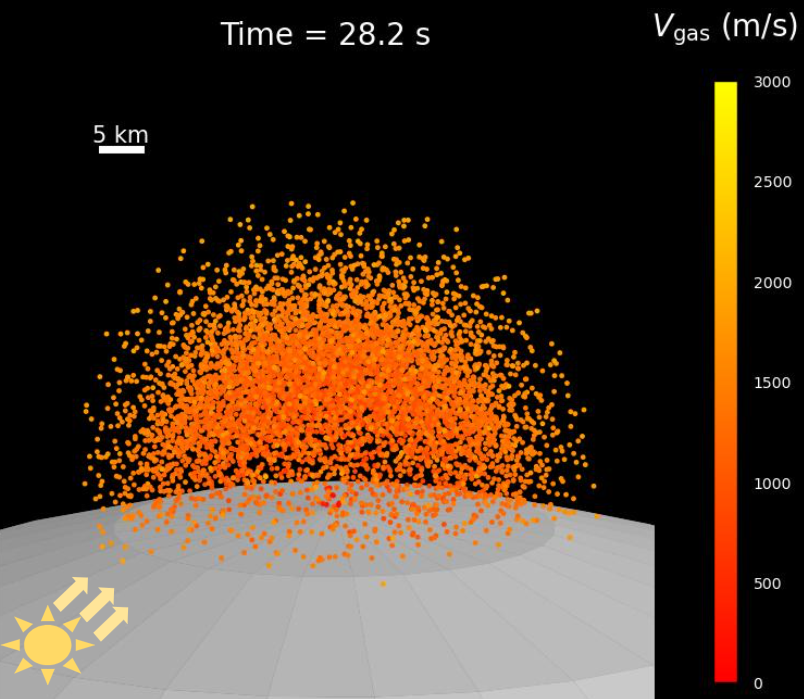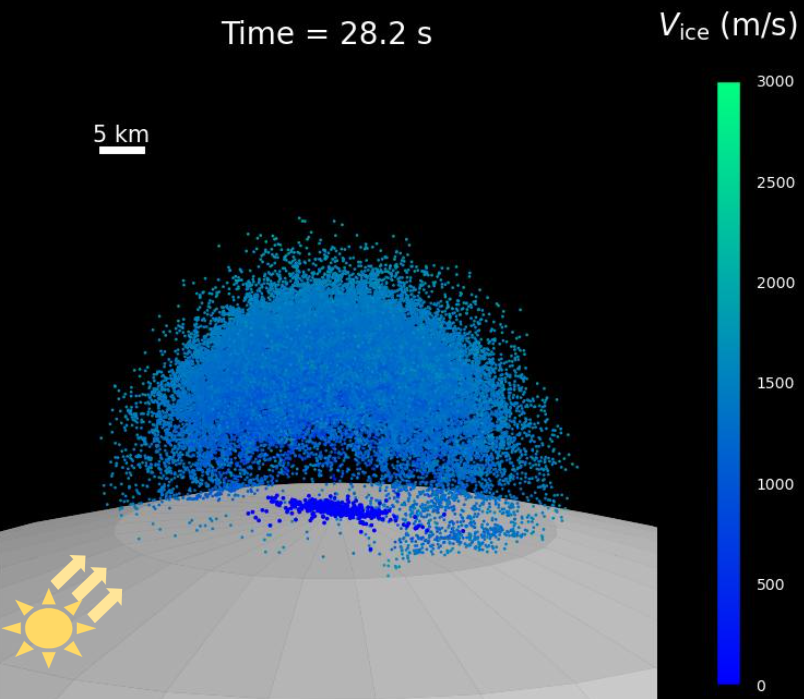- 1Department of Mathematics and Physics, University of Campania Luigi Vanvitelli, Viale Abramo Lincoln, 5, Caserta 81100, Italy
- 2INAF-IAPS, Via del Fosso del Cavaliere, 100, Roma 00133, Italy
- 3Department of Physics, University of Rome Tor Vergata, Via della Ricerca Scientifica, 1, Roma 00133, Italy
Introduction
Studying the emission of volatiles from planetary surfaces provides fundamental insights concerning the formation and evolution of planetary bodies, as well as their internal structure. A complex interplay occurs between hydrodynamic and thermal processes in several scientific cases, like the plumes outgassing from fractures over the surface of the icy satellites Europa and Enceladus [1-6]. By means of a Smoothed Particle Hydrodynamics (SPH) [9-11] approach, we simulate Enceladus’ plumes, mainly composed of water vapour and icy-grains [7-8]. We show preliminary results stressing the importance of modelling phase transitions, thermal and dynamical interactions with the solid boundaries as well as the solar radiation and the viscosity coupling between gas and grains.
Methods
For our simulations, we use PySPH [12], a Python framework for SPH. It allows us to study the evolution of a multi-component fluid using the Lagrangian approach, following the variation of its physical quantities, even when they rapidly change. We numerically integrate the hydrodynamics equations for the density, velocity and thermo-kinetic energy. We take into account phase transitions from water vapour to icy-grains and their possible sublimation as well, occurring either during flight or solid boundary interactions. Furthermore, we also consider the viscous drag and the solar radiation effect [13-14].
Initial and boundary conditions: we simulate a surface fracture filled with a finite amount of water vapour only, at saturated conditions and at the triple point of water. We mirror particles crossing fracture walls, and we also consider the thermal interaction with the main body surface. Phase transitions can then occur at the surface too. Finally, particles escaping outward the Hill radius are removed.
Results
Our main results concern the effect of the phase transitions, solar radiation, viscous drag and boundary interaction in altering the plume’s spatial, kinematical and thermal structure, its gas/ice fraction and the ice deposition over the surface.
Gas-ice dynamical coupling: when the icy-grains completely follow the gas (for infinitely small grain-sizes), they accelerate due to gas pressure. In the opposite regime of complete decoupling (for very large grain-sizes), ice particles follow ballistic trajectories and are slower than the gas component. The intermediate regime requires the viscous drag acceleration term in the momentum equation. Appropriate modelling is required to convert such microscopic processes into the macroscopic behaviour of each component. Preliminary simulations of Enceladus’ plumes show that a grain-size of ~100 μm gives a small fraction of icy particles coupled with the gas, although the velocity distributions are similar, as shown in Fig. 1.


Figure 1: Gas and ice velocity distribution in an Enceladus plume, calculated after ~28 s of simulation time. The Sun radiation direction is also shown.
Solar radiation and thermal boundary interactions: the solar radiation adds energy to illuminated particles, preventing very low temperatures that can be obtained from a free expansion in space. However, at Enceladus distance such flux is not high enough to prevent water ice formation, with a consequent predominance of icy-grains with respect to the vapour in the plume composition. The cold surface of Enceladus can efficiently allow phase transitions through heat conduction, causing ice deposition mainly around the emitting fracture, as shown in Figure 2, where we plot the density of deposited ice. Simulating a fixed amount of material naturally brings to an episodic mass loss event, which lasts a few seconds.
Figure 2. Icy-grains deposition near the emitting region after t~28 s. The fracture is a rectangular box with a section of 200 m2 and 200 m deep.
Conclusion
Our goal is to provide a flexible code for SPH simulations, that includes the modelling of several important processes altering volatiles emission from planetary surfaces, like the treatment of solid boundary interactions. This could also be achieved by merging other codes previously developed for modelling surface and subsurface physics [15]. A connection between Eulerian and Lagrangian codes can be a strong and useful tool in a wide range of planetary science studies. We plan to further improve the code, by including radiative transfer processes, adding the presence of dust and improving the assumptions mentioned above. The large applicability of SPH and our modelling offers an important tool for application to different planetary bodies, wherever volatile emissions occur. Among them, we can study post-impact plumes of small objects or the sublimation of ice on cometary surfaces, with the associated release of dust and gas, or sublimation from polar caps (as in the Martian case). It also enables refining models for Europa’s plumes, helping in planning and interpreting future observations of JUICE and Europa Clipper missions.
References
[1] Schmidt et al. 2008, Nature, 451, 685.
[2] Kempf et al. 2010, Icarus, 206, 446-457.
[3] Dong et al. 2011, J. Geophys. Res., 116.
[4] Roth et al. 2014, Science, 343, 171.
[5] Sparks et al. 2016, ApJ, 829, 121.
[6] Yeoh et al. 2017, Icarus, 281, 357.
[7] Ingersoll & Ewald 2011, Icarus, 216, 492.
[8] Postberg et al. 2018, Nature, 558, 564.
[9] Gingold & Monaghan 1977, MNRAS, 181, 375.
[10] Lucy 1977, AJ, 82, 1013.
[11] Monaghan, 2005, Rep. Prog. Phys. 68, 1703.
[12] R. Ramachandran et al. 2021, ACM Trans. Math. Softw. 47, 34.
[13] Magni et al. 2024, in preparation.
[14] Teodori et al. 2024, in preparation
[15] Formisano et al. 2018, J. Geophys. Res. 123, 2445.
Acknowledgments: This work was partially supported by INAF-IAPS within the ASI-INAF grant n. 2023.3.HH.0 “Attività Scientifica di preparazione all'esplorazione marziana" and ISSI within the project “Thermophysical Characterization of Ice-Rich Areas on the Surface of Specific Planetary Bodies: Conditions for the Formation of a Transient Exosphere”.
How to cite: Teodori, M., Maggioni, L., Magni, G., Formisano, M., De Sanctis, M. C., Altieri, F., and D'Aversa, E.: Volatiles emissions from surface fractures: Enceladus' plumes through Smoothed Particle Hydrodynamics simulations, Europlanet Science Congress 2024, Berlin, Germany, 8–13 Sep 2024, EPSC2024-55, https://doi.org/10.5194/epsc2024-55, 2024.